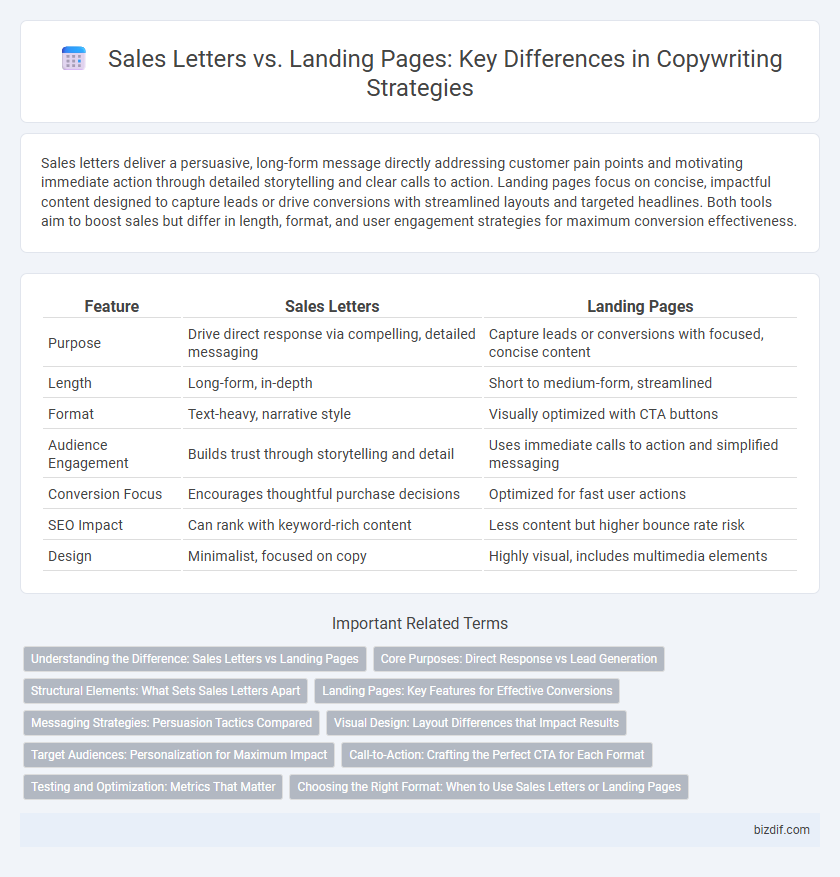Sales letters deliver a persuasive, long-form message directly addressing customer pain points and motivating immediate action through detailed storytelling and clear calls to action. Landing pages focus on concise, impactful content designed to capture leads or drive conversions with streamlined layouts and targeted headlines. Both tools aim to boost sales but differ in length, format, and user engagement strategies for maximum conversion effectiveness.
Table of Comparison
| Feature | Sales Letters | Landing Pages |
|---|---|---|
| Purpose | Drive direct response via compelling, detailed messaging | Capture leads or conversions with focused, concise content |
| Length | Long-form, in-depth | Short to medium-form, streamlined |
| Format | Text-heavy, narrative style | Visually optimized with CTA buttons |
| Audience Engagement | Builds trust through storytelling and detail | Uses immediate calls to action and simplified messaging |
| Conversion Focus | Encourages thoughtful purchase decisions | Optimized for fast user actions |
| SEO Impact | Can rank with keyword-rich content | Less content but higher bounce rate risk |
| Design | Minimalist, focused on copy | Highly visual, includes multimedia elements |
Understanding the Difference: Sales Letters vs Landing Pages
Sales letters are long-form persuasive texts designed to engage readers through storytelling and detailed product benefits, often delivered via email or traditional mail. Landing pages are web-optimized single pages focused on immediate conversion with concise messaging, clear calls-to-action, and user-friendly design. Understanding the difference helps marketers tailor content strategies to maximize engagement and drive specific customer actions effectively.
Core Purposes: Direct Response vs Lead Generation
Sales letters are crafted to trigger immediate direct response, compelling readers to take immediate action such as making a purchase or signing up for a service. Landing pages primarily focus on lead generation by capturing visitor information through forms, nurturing potential customers for future marketing efforts. Both tools leverage persuasive copy but serve distinct strategic goals within the marketing funnel.
Structural Elements: What Sets Sales Letters Apart
Sales letters distinguish themselves through a personalized, narrative-driven structure designed to build rapport and emotional connection with the reader, often incorporating a clear problem-solution framework. They typically feature a compelling headline, persuasive storytelling, a strong call-to-action, and detailed benefits to create urgency and trust. Landing pages prioritize concise, visually engaging layouts with prominent call-to-action buttons, but sales letters excel in deeper engagement by guiding prospects through a carefully crafted, persuasive argument.
Landing Pages: Key Features for Effective Conversions
Landing pages are designed with focused content and clear calls-to-action to drive higher conversion rates, eliminating distractions common in sales letters. Key features include responsive design, fast loading times, and persuasive headlines that resonate with target audience intent. Integrating social proof, such as testimonials and reviews, enhances credibility and encourages immediate user engagement.
Messaging Strategies: Persuasion Tactics Compared
Sales letters employ direct, emotional appeals and storytelling to build trust and create urgency, often using personalized language and compelling calls to action to drive conversions. Landing pages prioritize clarity and simplicity, utilizing headlines, bullet points, and visual hierarchy to quickly communicate value propositions and guide visitors toward a specific action. Both leverage persuasive elements, but sales letters rely more on narrative engagement while landing pages focus on immediate clarity and streamlined user experience.
Visual Design: Layout Differences that Impact Results
Sales letters typically use a linear, text-heavy layout emphasizing persuasive, narrative-driven copy designed to guide readers step-by-step toward a conversion. Landing pages prioritize a visually engaging, modular design with clear headlines, bullet points, and prominent calls-to-action to capture attention and encourage immediate interaction. The visual hierarchy in landing pages leverages whitespace, images, and responsive design elements to enhance user experience and boost conversion rates more effectively than traditional sales letters.
Target Audiences: Personalization for Maximum Impact
Sales letters and landing pages both rely heavily on targeted personalization to engage diverse audiences effectively. Sales letters allow for tailored messaging that addresses specific customer pain points and motivations directly, enhancing emotional connection and trust. Landing pages utilize dynamic content and segmentation techniques to deliver personalized user experiences that drive higher conversion rates by matching the visitor's intent and preferences.
Call-to-Action: Crafting the Perfect CTA for Each Format
Sales letters require a compelling, personalized call-to-action that guides readers through a narrative, encouraging them to take immediate, decisive action such as making a purchase or requesting more information. Landing pages benefit from clear, concise CTAs with strong visual elements like buttons that stand out, designed to capture leads or prompt conversions quickly. Tailoring CTAs to the format increases engagement, enhances user experience, and drives higher conversion rates in both copywriting contexts.
Testing and Optimization: Metrics That Matter
Sales letters and landing pages require rigorous testing to identify which elements drive higher conversion rates, including headline effectiveness, call-to-action clarity, and overall user engagement. Key metrics such as click-through rate (CTR), bounce rate, and conversion rate provide actionable insights to optimize copy, design, and layout for maximum impact. Split testing (A/B testing) remains essential for determining the most persuasive messages and layout variations that align with target audience behavior.
Choosing the Right Format: When to Use Sales Letters or Landing Pages
Sales letters excel in delivering detailed, persuasive narratives ideal for high-value offers requiring trust-building and in-depth explanation, while landing pages serve best for concise, action-driven content designed to capture leads quickly or drive immediate conversions. Selecting the right format depends on the product complexity, target audience, and campaign goals, with sales letters optimizing for engagement and education and landing pages optimizing for speed and clarity. Understanding buyer intent and communication style ensures effective message delivery and maximizes conversion potential.
Sales Letters vs Landing Pages Infographic

 bizdif.com
bizdif.com